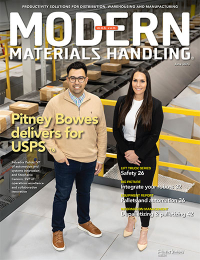Depalletizing and palletizing gain in flexibility
AI and vision technology are making robotic depalletizing and palletizing solutions more flexible, but master data on SKUs still needs attention, and palletizing needs proper buffering and sequencing of cases to optimize the pallet build.
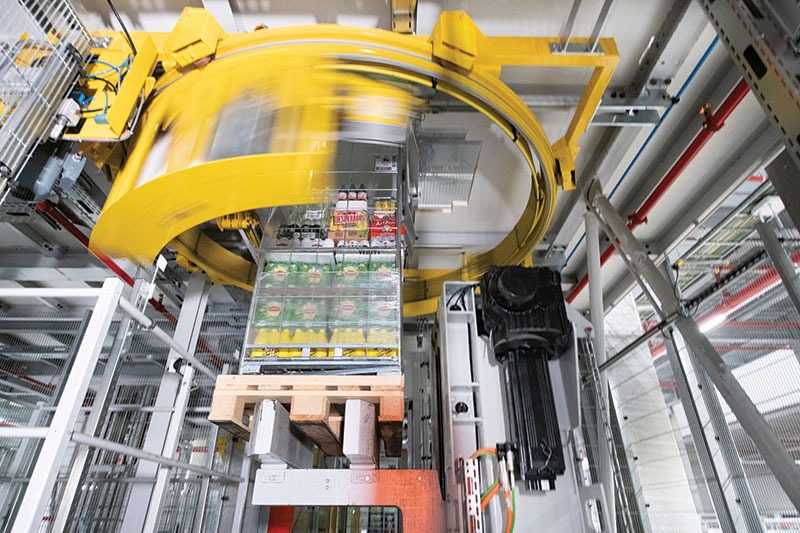
The promise of artificial intelligence (AI) and vision technology is starting to make robotic automation of depalletizing and palletizing more flexible, and in the process, opening it up to a broader set of users.
For years, articulating robotic arms and other types of industrial robots have been used for end-of-line palletizing of single SKUs, but now vision and AI are opening up new approaches to palletizing mixed-SKU pallets, while these foundational technologies are increasingly being used in depalletizing to discern how to grasp and handle cases or other units like bagged goods.
These advances are coming at a good time, since it’s difficult to find enough workers to do physically demanding manual case handling tasks, resulting in a constant struggle with turnover and concerns about keeping up with service levels.
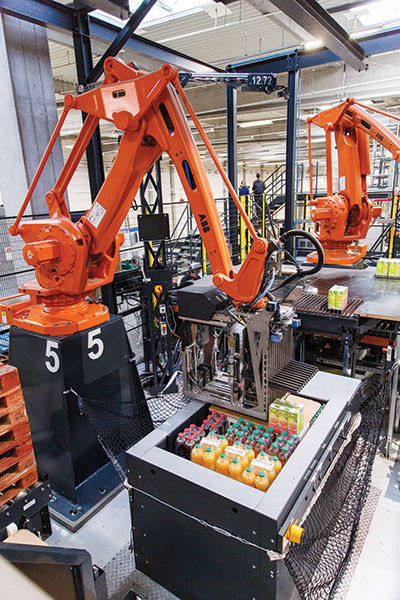
The struggles of relying on manual depalletizing and palletizing are not new, but reached a nadir during the height of the pandemic when it was hard to find enough frontline workers, says Jake Heldenberg, head of solutions design, warehousing for Vanderlande, North America.
“The pandemic was a catalyst for the high level of interest in this automation, but now that Covid isn’t impacting us to the same degree, the driver is more broadly about coping with market volatility, and how that volatility impacts the reliability of your warehouse processes,” says Heldenberg. “Companies want to be sure that they’re able to get product out the door even in the face of the latest market volatility.”
Robotic palletizing is often paired with high-density automated storage solutions, like case shuttle systems, to properly buffer and sequence goods needed to build mixed SKU pallets for outbound distribution. But robotic palletizing doesn’t necessarily require a shuttle to route cases to a cell or pallet conveyor automation. Autonomous mobile robots (AMRs) are making it possible to feed goods to robots in a more flexible manner.
In short, you have multiple considerations when setting up effective robotic palletizing and depalletizing, but AI and vision are increasingly being applied, while other forms of robotics are making it feasible to more flexibly automate inter-connected processes.
Why a shuttle?
Robotic palletizing cells often get fed cases by high density shuttles, which buffer and feed out cases as needed to build up pallets for store replenishment or distribution, especially when it comes to high volume DCs that might hold 35,000 SKUs, says Heldenberg.
A shuttle can hold a large volume of cases in minimal square footage, Heldenberg explains, and feed them out in the sequence needed to meet orders. “You really need that sequencing to properly palletize automatically,” says Heldenberg.
New SKUs being added to a robotic palletizing and shuttle system typically go through a one-time “teach-in” process so the overall system has accurate master data on case dimensions and other characteristics, adds Heldenberg. The teach-in process is also where rules for fragility or other factors are set so the load-forming software for the palletizing cell can reliably and quickly figure out patterns and good loads.
“The software managing the pallet build is taking in all those parameters that are captured during the teach-in process,” Heldenberg says.
The load forming software can optimize a pallet build to be transportation-friendly or store-friendly. To create a store-friendly pallet, says Heldenberg, the store layouts are fed into the software so the palletizing robot builds the pallet as close as possible to the order it will be unloaded at the store, saving labor.
Similarly, with a transportation-friendly pallet, the load-forming logic will maximize the height of each pallet load to more fully cube-out trailers. “The business case for robotic palletizing is often just as much savings out of the DC in transportation cost reductions of saving on store labor,” notes Heldenberg.
Vision is used in Vanderlande’s robotic palletizing solutions, mainly to ensure proper case orientation, Heldenberg says, rather than for SKU learning. “We use vision to confirm that the cases are indeed there and the location of those cases because the palletizing robot needs to orient those cases correctly before they go onto the pallet,” he says.
Flexibility and AMRs
Robotic palletizing eliminates a physically tough task and allows workers to take on other workflows, but it can also add speed versus the manual process of picking cases to a pallet rider or lift truck, notes Josh Cloer, director of sales with Mujin.
“Manual case picking can be super labor intensive,” Cloer says. “That manual case pick tends to go really slow because there is a lot of walking involved.”
Mujin’s application of vision and AI is part of its Machine Intelligence (MI) platform, which uses a compact controller to manage the technology that is part of the cell. In addition to AI, it uses sensors on end-of-arm tools (EOATs) to capture tactile feedback and gauge the weight of cases. The platform also includes the load building and packing logic software need for the cell.
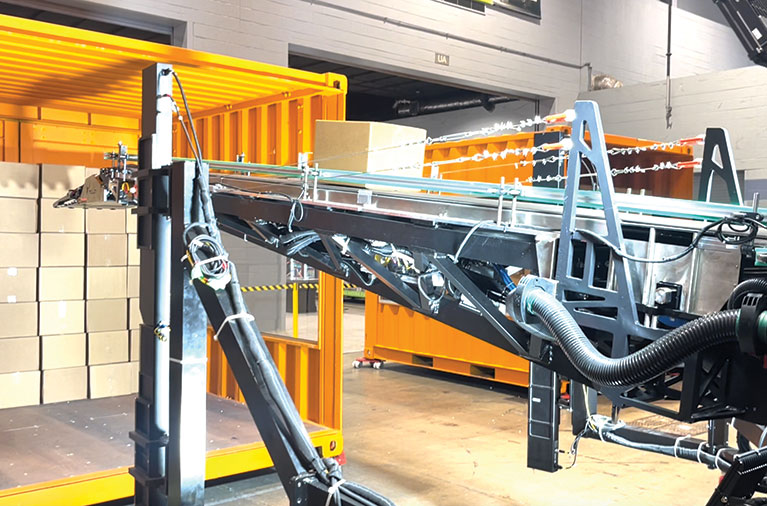
“The big changes around robotic palletizing are these algorithms for packing that permit the solution to, on the fly, be able to assess and calculate what needs to be picked up and what needs to be packed, and what the crush factors and stability factors should be,” says Cloer. “There’s a lot that goes into it—I wouldn’t say it’s all AI magic. Our Machine Intelligence is like a digital twin environment that understands the constraints of the cell and motion plans on the fly, streaming in data to support how to best interact with the scene.”
Mujin offers a mixed-case palletizing solution with intelligent buffer and resequencing functionality built into the software and functionality. This provides the needed buffering and sequencing of cases as part of the cell design, typically using a table to hold cases in buffer, next to the robotic arm, without needing to have an upstream automated storage and retrieval system (AS/RS).
“This functionality basically determines, ‘hey, this looks like a case that goes well on the bottom, or will go well in the middle, depending on progress of the pallet build, or this case can go to the buffer as the cell receives more cases, and then the system can make a decision about when to palletize those cases in buffer,” Cloer says.
Mujin’s cell-level buffering and sequencing makes robotic palletizing more feasible for smaller volume operations, Cloer adds, because they don’t need to have a shuttle upstream. It’s also possible to use large-format AMRs or autonomous forklifts to move pallets in and out of a robotic palletizing solution, which further holds down costs versus traditional pallet conveyance.
“We can just take some mobile robots and bring full inventory pallets to a robot cell, pick directly from those pallets and pack a mixed order onto another pallet, all within the cell, and then take away the completed mixed SKU pallet with another mobile robot,” Cloer says. “That can be a more cost-effective approach for lower volume warehouses, compared to installing a big shuttle system.”
Mujin also offers a robotic solution called TruckBot that attaches to telescoping conveyor, and grasps and unloads cases from a truck onto the conveyor, which could then route the cases to a robotic palletizing cell. “The next step after case unloading from a trailer is often palletizing,” Cloer says “Now with robotics you can automate that broader workflow.”
AI meets depalletizing
Bastian Solutions has seen strong interest in robotic depalletizing and palletizing applications, says Steven Hogg, Bastian’s application engineering manager for robotics, largely due to labor availability and turnover challenges.
On top of that, Hogg also sees advances in autonomous truck unloading and autonomous vehicles making it possible to automate multiple inter-connected process steps, such as unloading, palletizing and put away with flexible robotics.
“Many companies are challenged by labor shortages within their facilities, and they’re realizing that robotics and autonomous vehicles can help them across key pain points, and with a higher degree of flexibility than in the past,” Hogg says.
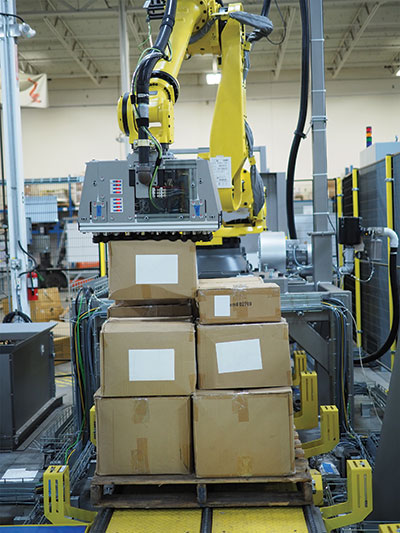
Advancements in vision and AI have made mixed-case depalletizing more feasible and adaptable for operations that deal with a large mix of SKUs, says Hogg, because the vision and AI can in effect see and make sense of each load and its pattern configuration, such as case dimensions, and how many cases/boxes are on a layer, he explains.
“To handle the wide range of load configurations for inbound receiving processes, the AI needs to be able to identify homogeneous, single SKU loads as well as accommodate loads that are rainbow or mixed-SKU,” says Hogg. “The AI allows the robotic depalletizing system to work autonomously, so the operators have the ability to put any load configuration into the system and it doesn’t have to be pre-programmed in to identify product for handling.”
This ability of AI and vision to make sense of mixed SKU loads to be depalletized and update the system’s knowledge on the fly makes robotic depalletizing more attractive to companies that need to depalletize a variety of SKUs. “Really, what AI has done is open the door to robotic depalletizing for more applications where customers need to deal with thousands of SKUs. It was not feasible in the past to program in or teach the system that many SKUs in advance, so product identification and the machine learning are happening autonomously through vision and AI.”
For some robotic mixed palletizing solutions, the sequencing and buffering of product is handled by some type of upstream AS/RS or shuttle, notes Hogg. These solutions do typically need master data on SKUs so the pallet pattern can be generated prior to product release from the sequencing system. Robotic buffering systems can be added to the design to help sequence the product for the palletizing process, adds Hogg.
Some under-appreciated aspects of robotic palletizing and depalletizing systems, adds Hogg, include the importance of working with the solution provider to develop an EOAT that best suits the products. Though EOATs can be changed between loads, and there are even automatic EOAT changing systems, EOAT design and selection remains an important solution aspect, he adds. “The EOAT has to be very flexible to handle a wide range of SKUs to fully utilize the power of the AI and get the most from the automation,” says Hogg.
Grip point variability
The main benefit of vision and AI is that they help robotic arms deal with variability and still perform rapidly and reliably, says Ken Fleming, CEO of Fizyr, which specializes in deep-learning vision software, partnering with integrators and end users who incorporate the software into solutions. Variability is higher on the depalletizing side, says Fleming, especially for mixed-case depalletizing where the cases are different sizes or shapes, or not neatly aligned.
Another scenario with high variability is depalletizing heavier bagged materials like powders or food additives where the bags shift in transit, says Fleming. Here, Fizyr’s vision software has been used to identify the best grip point.
“Because they’ve shifted, there’s more variability in finding that center gripping point for each bag, and for us, that’s where vision and vision software kick in,” says Fleming. “With vision, a solution can rapidly determine where that center gripping point should be, even if shifting has made things less predictable.”
Beyond labor availability challenges driving interest in robotic depalletizing, you have regulatory concerns, notes Fleming. The European Union, for instance, limits the maximum weight workers can lift to 25 kilos, and there is discussion of lowering this maximum.
The upshot of such concerns is that more companies are looking at robotics solutions as a way to reduce the risk of not having enough labor to hit throughput goals and service levels. “More and more companies are saying, ‘OK, now I want start taking a look at robotic solutions to address these challenges,’” says Fleming.
Robotics and vision technology solutions have to be fast and reliable to make deployments attractive, adds Fleming. He says Fizyr’s software can go from image to command in 1/100th of a second with high reliability. “When that level of performance happens with high reliability, then you can get the efficiencies needed to completely automate some of these processes with high variability,” says Fleming.
Know your SKUs
Unlike manufacturing where robotic cells are often repeating the same procedure with the same parts, in intralogistics, variability is the name of the game, and that is where AI helps, says Dean Priebe, senior director of robotics at Dematic.
“When you look at robotics in supply chain and intralogistics, you don’t have the same problem or task in front of the robot every day,” Priebe says. “The solutions need to handle multiple different SKUs, case sizes, packaging differences, and then the environment is changing. On a humid day, it may be that the cardboard on the pallet has increased in thickness just a little bit. All these variables come into play. But with the tools of vision and AI you start to track these variables and learn from them, which improves the system over time.”
However, adds Priebe, AI and vision aren’t a guarantee of a successful deployment. Companies still need to manage master data on package and SKU characteristics and feed the appropriate data into the system, and SKUs may need to be sequenced and buffered in front of a mixed case palletizing cell, often using a case AS/RS or shuttle.
AMRs can be used in some situations to bring goods or empty pallets to robotic cells, but for complex palletizing of mixed cases requiring maximum cube utilization, a shuttle is an ideal solution because it will buffer and sequence the needed cases in the order the robotic cell will process them, Priebe explains.
What’s more, says Priebe, in industry sectors such as grocery where warehouses want to generate store-ready pallets that are easier to stock shelves with, store layout or “planograms” need to be updated and maintained for the load building software to do its thing.
As a result, says Priebe, end-users of robotic palletizing and depalletizing, even those with AI and vision as part of the solution, need to learn on how to maintain master data, feed new data from suppliers into the system, keep store layouts updated, as well as learn how to interact with the robotic cell’s user interface.
“It’s also important to educate customers on how to get the best use from robotics,” says Priebe. “It’s like buying a new tool for your house. The 30th time you use it, you’ll be better at it than the first time. So, there’s this need to educate and partner with our customers through that early startup phase so they are fully prepared to run the system. Ideally, they are mastering the SKU set and the characteristics of the inventory that will be coming through the system. The better the end users understand their SKU sets, the better we can work with them to define the rules for how those SKUs will be processed by the automation.”
Today, the drivers for robotic palletizing and depalletizing are less about incremental cost savings, Priebe concludes, and more about operational stability, since some DCs can’t count on finding enough workforce to do things more manually. “The turnover rates are so high, it’s a costly process of getting new people in, training them, losing them and starting over,” Priebe says. “We have customers now where part of their ROI rationale is that they know they can’t get enough labor, so they know they must solve this problem.”

Article Topics
Bastian Solutions News & Resources
Movu Robotics and Bastian Solutions partner to offer flexible robotics solutions GEODIS maximizes flexibility and minimizes touches Exotec adds Bastian Solutions as newest regional integrator in North America Special Digital Issue: Warehouse/DC Robotics Depalletizing and palletizing gain in flexibility Bastian Solutions reveals automated guided forklift Bastian Solutions unveils plans for new corporate campus in Noblesville, Indiana More Bastian SolutionsLatest in Materials Handling
ASME Foundation wins grant for technical workforce development The (Not So) Secret Weapons: How Key Cabinets and Asset Management Lockers Are Changing Supply Chain Operations MODEX C-Suite Interview with Harold Vanasse: The perfect blend of automation and sustainability Consultant and industry leader John M. Hill passes on at age 86 Registration open for Pack Expo International 2024 Walmart chooses Swisslog AS/RS and software for third milk processing facility NetLogistik partners with Vuzix subsidiary Moviynt to offer mobility solutions for warehouses More Materials HandlingAbout the Author
Subscribe to Materials Handling Magazine

Find out what the world's most innovative companies are doing to improve productivity in their plants and distribution centers.
Start your FREE subscription today.
April 2024 Modern Materials Handling

Latest Resources


